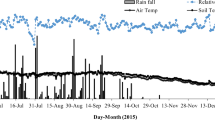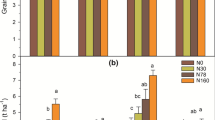Abstract
A field experiment was conducted on a poorly-drained Aeric Paleaquult in northeastern Thailand to determine the effect of N and S fertilizers on yield of rainfed lowland rice (Oryza sativa L.) and to determine the fate of applied15N- and35S-labeled fertilizers. Rice yield and N uptake increased with applied N but not with applied S in either sulfate or elemental S (ES) form. Rice yield was statistically greater for deep placement of urea as urea supergranules (USG) than for all other N fertilizer treatments that included prilled urea (PU), urea amended with a urease inhibitor (phenyl phosphorodiamidate), and ammonium phosphate sulfate (16% N, 8.6% P).
The applied15N-labeled urea (37 kg N ha−1) not recovered in the soil/plant system at crop maturity was 85% for basal incorporation, 53% for broadcast at 12 days after transplanting (DT), 27% for broadcast at 5–7 days before panicle initiation (DBPI), and 49% for broadcast at panicle initiation (PI). The basal incorporated S (30 kg ha−1) not recovered in the soil/plant system at crop maturity was 37% for sulfate applied as single superphosphate (SSP) and 34% for ES applied as granulated triple superphosphate fortified with S (S/GTSP). Some basal incorporated15N and35S and some broadcast15N at PI was lost by runoff. Heavy rainfall at 3–4 days after basal N incorporation and at 1 day after PI resulted in water flow from rice fields at higher elevation and total inundation of the 0.15-m-high15N and35S microplot borders. Unrecovered15N was only 14% for 75 kg urea-N ha−1 deep placed as USG at transplanting. This low N loss from USG indicated that leaching was not a major N loss mechanism and that deep placement was relatively effective in preventing runoff loss.
In order to assess the susceptibility of fertilizer-S to runoff loss, a subsequent field experiment was conducted to monitor35S activity in floodwater for 42 days after basal incorporation of SSP and S/GTSP. Maximum35S recoveries in the floodwater were 19% for SSP after 7 days and 7% for S/GTSP after 1 day. Recovery of35S in floodwater after 14 days was 12% for SSP and 3% for S/GTSP.
This research suggests that on poorly drained soils with a low sorption capacity, a sizeable fraction of the fertilizer S and N remains in the floodwater following application. Runoff could then be an important mechanism of nutrient loss in areas with high probability for inundation following intense rainfall.
Similar content being viewed by others
References
Barrow NJ (1967) Studies on the adsorption of sulfate by soils. Soil Sci 104: 342–349
Blair GJ (1979) Sulfur in the tropics. Tech Bull IFDC-T-12. Muscle Shoals, Alabama: International Fertilizer Development Center
Buresh RJ, Austin ER and Craswell ET (1982) Analytical methods in15N research. Fert Res 3: 37–62
Cao ZH, De Datta, SK and Fillery IRP (1984) Nitrogen-15 balance and residual effects of urea-N in wetland rice fields as affected by deep placement techniques. Soil Sci Soc Am J 48: 203–208
Chien SH, Hellums DT and Henao J (1987) Greenhouse evaluation of elemental sulfur and gypsum for flooded rice. Soil Sci Soc Am J 51: 120–123
Chien SH, Friesen DK and Hamilton BW (1988) Effect of application method on availability of elemental sulfur in cropping sequences. Soil Sci Soc Am J 52: 165–169
Craswell ET, De Datta SK, Obcemea WN and Hartantyo M (1981) Time and mode of nitrogen fertilizer application to tropical wetland rice. Fert Res 2: 247–259
De Datta SK, Obcema WN, Chen RY, Calabio JC and Evangelista RC (1987) Effect of water depth on nitrogen use efficiency and nitrogen-15 balance in lowland rice. Agron J 79: 210–216
Freney JR and Boonjawat J (1983) Sulfur transformations in wetland soils. In: Blair GJ and Till AR (eds) Sulfur in Southeast Asian and South Pacific Agriculture, pp 28–38. Armidale, NSW, Australia: University of New England
Garrity DP, Oldeman LR and Morris RA (1986) Rainfed lowland rice ecosystems: characterization and distribution. In: Progress in Rainfed Lowland Rice, pp 3–23. Los Baños, Laguna, Philippines: International Rice Research Institute
Hoult E, Andrews E and Keerati-Kasikorn P (1983) Sulfur deficiencies in the agriculture of Thailand, Kampuchea, Laos and Vietnam. In: Blair GJ and Till AR (eds) Sulfur in Southeast Asian and South Pacific Agriculture, pp 115–146. Armidale, NSW, Australia: University of New England
Katyal JC, Singh Bijay, Vlek PLG and Craswell ET (1985) Fate and efficiency of nitrogen fertilizers applied to wetland rice. II. Punjab, India, Fert Res 6: 279–290
Korentajer L, Byrnes BH and Hellums DT (1984) Leaching losses and plant recovery from various sulfur fertilizers. Soil Sci Soc Am J 48: 671–676
Mitsuchi M, Wichaidit P and Jeungnijnirund S (1989) Soils of the Northeast Plateau, Thailand. Tech Bull 25. Ohwashi, Tsukuba, Ibaraki, Japan: Tropical Agriculture Research Center
Ragland J and Boonpuckdee L (1988) Fertilizer responses in Northeast Thailand: 4. Nutrient and pH buffering capacities. Thai J Soils Fert 10: 134–147
Satrusajang A, Snitwongse P and Buresh RJ (1988) Loss of nitrogen fertilizer applied to lowland rice on an acid sulfate soil. In: Proceedings First International Symposium on Paddy Soil Fertility. 6–13 December 1988. Chiangmai, Thailand, pp 571–586
Songmuang P, Sritananda W, Naklang K, Toechantueg S, Rojanakusol S, Hemtanonta B and Aguru Y (1985) Long term trial on sulfur fertilization in wetland rice. In: 1985 Annual research report on rice soil and fertilizer experiment. Bangkok: Soil Science Division, Thailand Department of Agriculture
Sritananda W, Laohaprasitporn L, Songmuang P, Jinda M, Toechantueg S, Piboonworakul P, Hemtanonta B, Petchawee S, Prongsiriwatana C, Kanareugsa C and Chaiwanakupt S (1985) The efficiency of phosphorus and sulfur in tropical cropping systems. IV. Rice-sandy loam soil at Ubon Ratchathani Rice Research Center. In: 1985 Annual research report on rice soil and fertilizer experiment. Bangkok: Soil Science Division, Thailand Department of Agriculture
Till AR, McArthur GS and Rocks RL (1984) An automated procedure for the simultaneous determination of sulfur and phosphorus and of radioactivity in biological samples. In: Sulfur-84 Proceedings, pp 649–660. Calgary, Alberta: Sulfur Development Institute Canada
Vlek PLG, Stumpe JM and Byrnes BH (1980) Urease activity and inhibition in flooded soil systems. Fert Res 1: 191–202
Vlek PLG and Fillery IRP (1984) Improving nitrogen efficiency in wetland rice soils. Proc. No. 230, London. 13 Dec. London: The Fertilizer Society
Wetselaar R (1985) Deep point-placed urea in a flooded soil: a mechanistic view. In: Stangel PJ et al. (eds) Proceedings of the Workshop on Urea Deep-Placement Technology, pp 7–14. Special Publication-SP-6. Muscle Shoals, Alabama: International Fertilizer Development Center
Author information
Authors and Affiliations
Rights and permissions
About this article
Cite this article
Satrusajang, A., Snitwongse, P., Buresh, R.J. et al. Nitrogen-15 and sulfur-35 balances for fertilizers applied to transplanted rainfed lowland rice. Fertilizer Research 28, 55–65 (1991). https://doi.org/10.1007/BF01048856
Received:
Accepted:
Issue Date:
DOI: https://doi.org/10.1007/BF01048856




